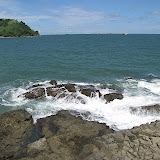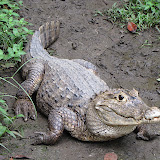Take a minute to check out their website. Culebra Island has an interesting history and lots of natural wonders we found worth exploring.
Be sure to take a look at the pics!
 |
| Amador Causeway |
31 days in Panama + 2010-11 school year tropical ecology unit
 |
| Amador Causeway |

By Sarah Perdue of the Journal Sentinel
Trees do not make good neighbors, at least to their own kind.
That so-called negative feedback, where young seedlings tend to die if an adult tree of the same species is nearby, is one way forests maintain diversity. Now, a group of researchers, including two scientists from the University of Wisconsin-Milwaukee, say they know how it happens.
Their results, published online Friday in the journal Nature, show that abundant tree species are less susceptible to disease inflicted by soil-borne organisms.
"People have approached this question and assumed that the major enemies are above ground, such as rodents or insects," said Scott Mangan, a post-doctoral researcher at UWM and the Smithsonian Tropical Research Institute and the lead author of the study. "Our paper suggests we have to consider what is below ground as well."
Working on Barro Colorado Island in the Panama Canal, the researchers selected six tree species found in forests there for a greenhouse experiment. They planted seedlings of each species in pots containing soil collected near adult trees of those same species - each species was planted in the six different soil types. They then measured the effects the soil had on the growth of seedlings from the various species.
"We wanted to test how seedlings perform in the presence of their own soil communities as opposed to other species' soil communities," Mangan said. "The worse a species does when grown with their own soil, the stronger the negative feedback."
Previous studies have suggested that predators of a specific tree grow in numbers as that species becomes more abundant in a forest. If that were true, the researchers would expect that seedlings of more abundant species show more negative feedback.
Instead, they found the opposite was true: More abundant species were less harmed by the soil communities. In other words, the soil communities are the cause of the diversity, not an effect.
"The species that are hit hardest by these (soil) organisms are always going to be lowest in abundance," said Stefan Schnitzer, a UWM professor of biology and co-author of the study.
The protective environment of a greenhouse does not perfectly mimic a forest, however, so the researchers needed to determine if the soil near adult trees in a forest has the same effect on seedling growth. They grew seedlings much like they had done in the greenhouse, only now they planted seeds in soil near adult trees in an established forest at Gigante Peninsula in mainland Panama, where rodents and insects could get to the seedlings.
"If it were insects driving this pattern, we'd expect leaf damage to be higher in offspring of the same species," Mangan said. Instead, they saw no pattern of leaf damage between the species, which meant the negative feedback they were seeing in the forest was also due to organisms in the soil.
Implicating soil-borne organisms in plant disease is not a new idea. Farmers, for example, rotate what they grow in a particular field from season to season to prevent crop-specific soil pests.
This study shows for the first time that the soil organisms are targeting seedlings in tropical forests in a way that helps to maintain the diversity of the forests.
"One of the great mysteries of lowland tropical rainforests is their extraordinary richness in tree species," said Stephen Hubbell, a professor of ecology and evolutionary biology at UCLA who was not involved in the research. "This is a marvelous, well-designed study that makes a major contribution to our understanding of how tropical forests work."
Mangan said the next step will be to identify the soil organisms that specifically affect each species.
"If we can identify the mechanisms and important organisms that are needed to maintain a diverse forest, that goes a long way when we are trying to, say, reforest a cleared area," he said.
We treated ourselves to all of the tourism attractions: a 10 minute documentary in the theater (very brief in comparison to David McCallough’s 600 page history), the exhibition hall houses a history of the construction of the canal, an ecological exhibit that highlights the canal’s watershed and some of the plants and animals found there, and a full scale pilot training simulator and route maps. But the highlight was being there in time to watch two ships go through the locks! The sun came out just in time for us to find a spot on the rooftop observation deck and take in all of the action.
Here is some canal trivia you can impress your friends with:
1. The main work on the Canal was completed in 1914. Construction of 3 new locks is underway. The expansion project will be completed in 2014.
2. The cost of building the canal was $380 million dollars. ($310 million for actual construction; $20 million for sanitation; $40 million paid to the original French companies; and $10 million paid to Panama for rights)
3. Construction employed more than 43,400 persons (at the height of activity in 1913).
4. It is estimated that 25,000 people died building the canal. That’s about 500 per mile.
5. Over 152.9 million cubic meters of land and was removed. Some of it was used to build the Amador Causeway. (More on that in future posts.) I don’t know where the rest of it went yet!
6. A ship traveling from New York to San Francisco can save 7,872 miles using the Panama Canal instead of going around the tip of South America.
7. It takes 24 hours to pass through the canal.
8. Today it costs between $200,000 and $250,000 to transit the canal. The smallest charge was 45 cent to swimmer Albert H. Oshiver, who swam through the locks in December, 1962.
9. Approximately 12,000 oceangoing vessels now pass through the Canal yearly, almost 35 a day.
10. The record of 14,807 ship transits was set in 1968.
11. Each lock in the Canal system is 1,000' long, 110' wide, and 70' deep. The new locks will be larger to accommodate even bigger ships that are now being built.
 |
| Summit Zoo & Miraflores Locks |